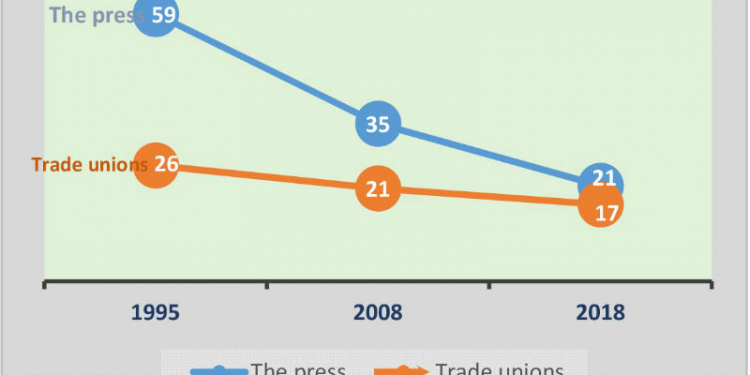After 29 years in the survey business with access to rich data archives, I can confidently describe the dynamics of Georgian society in numbers and speculate about trends. In previous columns, I wrote about the evolution of positive attitudes towards the Georgian armed forces and how trust in political parties has dramatically declined over the last two decades. In this column I will present trust curves of two other important institutions: the press and trade unions. Why the press and trade unions in the same column? Simply because both are important pillars in any modern society that can sometimes be very useful in improving quality of life. And, you can see the drastic declines of both by glancing at Chart 1.
Trade Unions (TU) have a long history in Georgia. Until 1990, they used to be important instruments for managing the working class and were much glorified during colorful May Day parades. Since Georgia’s independence, their only major achievement was getting Georgia to join the International Labor Organization and ratify basic labor rights conventions. Well, to be fair, in recent times they have also attempted to bargain for increases in salaries and safety for coal miners and metro drivers.
After the collapse of the Soviet system, Georgian TUs began “privatizing” inherited state assets at a frenzied pace, and the interests of the workers were largely confined to the dustbin. During this period of wild capitalism, TUs effectively operated as regular criminal organizations, stealing property and cash that had been collected during the previous 70 years. The same happened with the Communist Party and the Young Komsomol Union, leaders and other “smart” people. They pocketed the money and, in some cases, later invested it back in banking or infrastructural projects.
I cannot recall any true TU achievements, but I do remember cases when employees were fired from large businesses such as banks and GSM companies during Saakashvili’s regime because they had attended opposition rallies. Business owners could not resist the “advice” of the security services and TUs were not in the position to back them up.
In 1995, when GORBI first measured trust towards TUs, the figure was a low 26%. Today, it’s even lower – only 17% of surveyed respondents have confidence in the institution. It is not surprising given the very rare appearance of TU leaders in the media to discuss their initiatives, and successful cases where they bargained with investors or local businesses.
Press is way older than the concept of TUs in Georgia. The country’s first newspaper “Sakartvelos Gazeti” (Georgia’s Newspaper) was published in 1819, containing stories about governments decrees, articles, news from Russia, etc. At first, only about 200 copies were printed, probably because of the low literacy rate and absence of distribution services at the time. Today, ironically, daily circulation is below 3,000 but weekly copies for one or two items exceeds 30,000, still a meager amount for a population of 3.7 million.
Under Soviet rule, Georgia had a few newspapers, which were very well distributed, had a huge circulation and were very cheap, cheaper than the propaganda they were preaching. After the first two decades following independence, Georgian print press had some ups but overall, the newspaper business is down and on its way out. Despite huge efforts from the international community, independent print form did not manage to transition to the digital era and failed to be competitive. The extinction of newspapers is well reflected in survey findings: 23 years ago, a majority (59%) of surveyed respondents had trust in the press. By 2018, this number had dropped to 21%, and the saga continues.
Based on the same data, respondents’ education and age is highly correlated with confidence in the press. While 34% of those with incomplete education have “a great deal” or “quit a lot” of confidence in the press, the same is true with only 2% of those with PhD degrees. Whereas almost every third (30%) elderly respondent (aged 65 or over) is confident in the press, among the youngest group of respondents (18-24-year-olds) only 13% share such confidence.
Overall, this sharp decline in confidence in the press and TUs is not good news. Yes, the internet will soon be universally-accessible in Georgia, and everyone will be able to receive and watch the news on their phones. But as in most developed democracies, print media still exists and in some countries (Australia is the good example) circulations are even recovering. I do not see a bright future for print media in Georgia; it feels like no one needs them and most efforts are now in the digital realm. We already have a few success stories of newly-established internet-based magazines and it seems they have some prospects.
As for TUs, I believe they have a future and should soon become stronger and more involved in generating employment and economic growth. After all, the small but still present labor class needs a lot of support, education on workers’ rights and organization to defend itself, as in any normal environment. But they will certainly need a lot of help from Georgia’s friends to catch up with the new realities and adequately address current challenges. I wonder if TUs will be the next target of the donor community or if selected NGOs will remain the privileged partners.
Note: I would like to extend special appreciation to Ani Lortkipanidze who assisted with the analysis and charts featured in this article
GORBI is an exclusive member of the Gallup International research network and has more than two decades of experience in survey research (gorbi.com)






























Discussion about this post